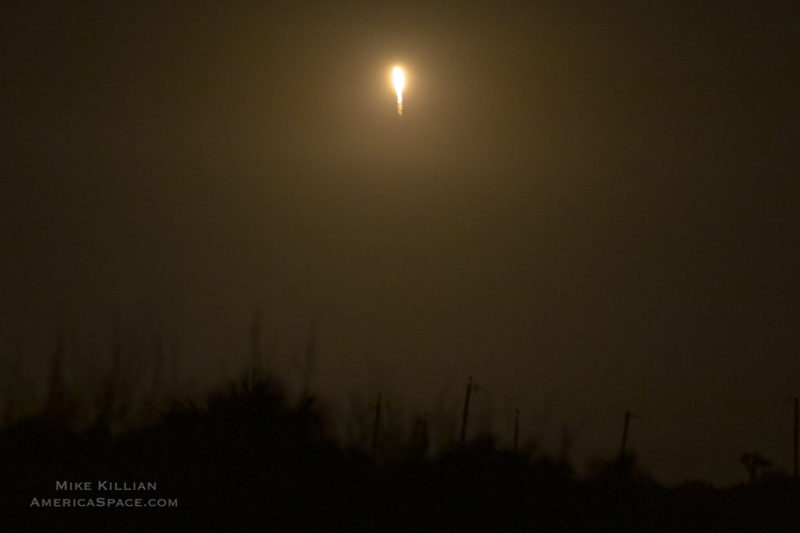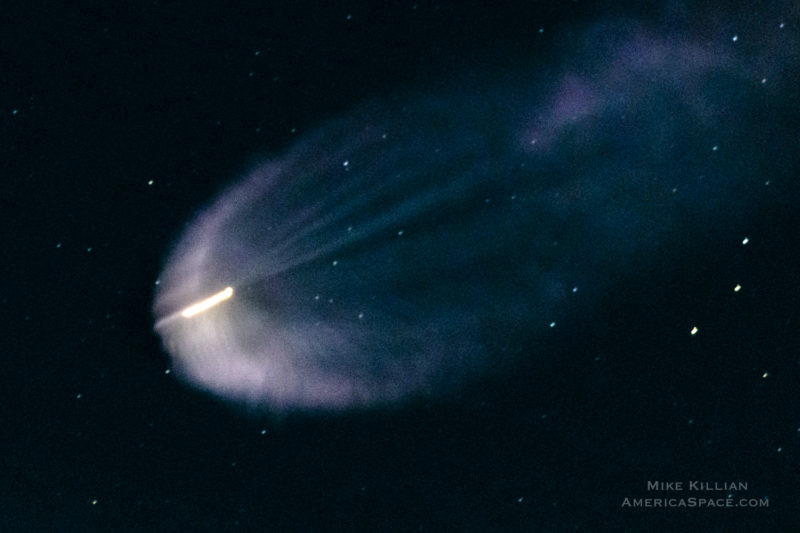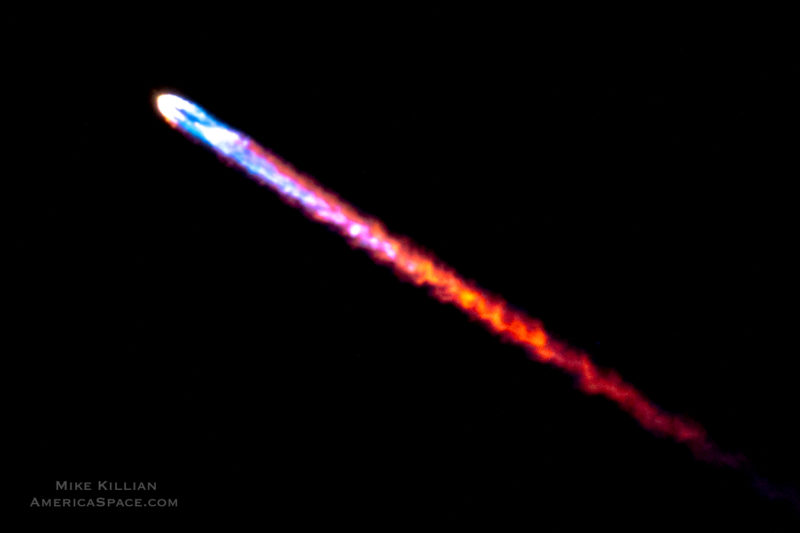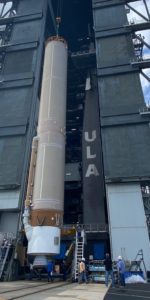
Just a quarter-hour shy of midnight in Florida, SpaceX successfully launched its 12th Falcon 9 of the year late Wednesday from historic Space Launch Complex (SLC)-40 at Cape Canaveral Space Force Station. Powering into the night under 1.7 million pounds (770,000 kg) of thrust from her nine Merlin 1D+ engines, the B1060 core stage rose from Earth at 11:44 p.m. EDT, laden with 60 Starlink low-orbiting internet communications satellites.
A little over eight minutes later, B1060—which became only the fourth Falcon 9 core to log a seventh flight and has now flown in each of the first four months of 2021—returned to a smooth touchdown on the deck of the Autonomous Spaceport Drone Ship (ASDS), “Just Read the Instructions”.
Weather conditions were near-perfect along the Space Coast, with the 45th Weather Squadron at Patrick Space Force Base predicting an 80-percent probability of suitable conditions at launch time.
“High pressure will gradually slide eastward into the Atlantic through early Thursday and quiet weather with breezy flow will continue across the Spaceport,” it noted in its Tuesday afternoon L-1 update. “Expect plentiful sunshine with winds shifting to the southeast. Brisk flow around the high-pressure ridge of 15-20 mph (24-32 km/h) will continue. As a result, the primary concern during the launch late Wednesday night will be Liftoff Winds.”
Last Friday—the very day that Crew-2 astronauts Shane Kimbrough, Megan McArthur, Aki Hoshide and Thomas Pesquet rode Dragon Endeavour to orbit—the ASDS was towed out to sea by the Hawk tug. However, due to apparent mechanical issues, its sister tug Finn Falgout was despatched from Port Canaveral on Tuesday to assume responsibility for hauling the ASDS out to its recovery location about 390 miles (630 km) offshore in the Atlantic Ocean.

Despite these apparent difficulties, SpaceX announced late Tuesday that it was still firmly targeting 11:44 p.m. EDT Wednesday for its third launch of April and its 12th Falcon 9 mission of the year.
Launching a dozen times in the first four months of 2021 achieves a new “personal best” for SpaceX, which had accrued only seven missions by this point last spring. And since 2020 wound up being the Hawthorne, Calif.-headquartered organization’s most prolific year to date—with 26 missions—this rapid tempo suggests that a new record for launch cadence may be achieved by next New Year’s Eve.
Additionally, the B1060 core stage itself has set multiple records. First flown last 30 June, she provided the muscle to boost the U.S. Space Force’s third Block III Global Positioning System (GPS) navigation and timing satellite towards Medium Earth Orbit (MEO), about 12,550 miles (20,200 km) above the planet.

Nine weeks later, on 3 September, she launched again—cementing a record for the shortest interval between two Falcon 9 flights from the Space Coast—and went on to fly a third mission on 24 October. Both were laden with 60-strong batches of Starlinks. On her third flight, B1060 marked the 100th successful launch of a Falcon-class booster.
But her real record-setting credentials have been concentrated into the first four months of 2021. She flew SpaceX’s first mission of the year on 7 January with Turkey’s powerful Türksat 5A geostationary communications satellite, then was turned around in only 27 days to fly a Starlink payload uphill on 4 February, in what SpaceX touted as “rapid reusability”.
This neatly eclipsed the Falcon 9’s previous launch-to-launch turnaround record of only 38 days, set a few weeks earlier. Most recently, on 24 March, she lofted another 60-strong Starlink batch of satellites to orbit. With tonight’s launch, she becomes the first Falcon 9 to fly in four consecutive months. And in less a year, she has now delivered 302 discrete satellites aloft, weighing a combined 189,000 pounds (85,700 kg).

Tonight’s 11:44 p.m. EDT liftoff was characteristically perfect and B1060 powered smoothly uphill, providing the first-stage muscle for the first 2.5 minutes of flight. She then separated from the Falcon 9 stack and began her descent—guided by a system of hypersonic grid-fins and Entry and Landing engine burns—towards the ASDS deck. Meanwhile, the Merlin 1D+ Vacuum engine of the second stage continued the push towards orbit and the 60 Starlinks were deployed a little over an hour after launch.
Despite one lost booster in February and more than a month of delays suffered by the life-leading B1049 before its most recent flight, the first 12 Falcon 9 missions of 2021 have now deposited a grand total of 550 Starlinks into low orbit, as well as Türksat 5A on the first leg of its trek to geostationary altitude. Additionally, Transporter-1 in January saw the largest single number of primary payloads—143—ever lifted by a U.S. launch vehicle.
And just last week, four astronauts from three nations headed to the International Space Station (ISS) aboard Dragon Endeavour, the first Crew Dragon vehicle to launch and visit the sprawling orbital outpost on as many as two occasions. All told, those 12 Falcon 9 missions have been executed by just six cores, one of which has now recorded nine launches.
.
.
FOLLOW AmericaSpace on Facebook and Twitter!
.
.






3 Comments
3 Pings & Trackbacks
Pingback:Falcon 9 Marks 4th Launch in Four Months With Midnight Starlink Mission
Pingback:Historic Cape Launch Pad Observes 125th Launch With First 10x-Flown Falcon 9 « AmericaSpace
Pingback:Historic Cape Launch Pad Observes 125th Launch With First 10x-Flown Falcon 9